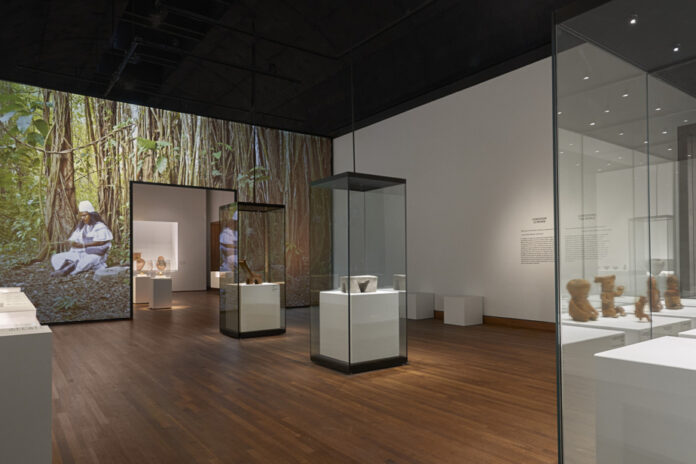The Montreal Museum of Fine Arts (MMFA) presents this summer the exhibition The Universe in the Palms of the Hands: Thoughts and Splendors of Indigenous Colombia, a new way of looking at the art of Colombia. With 400 small ceramic or goldsmith objects, messenger works requiring great technical mastery and which tell a vision of the world and the environment that the West has not yet fully understood…
This exhibition, scenographed with sobriety in several rooms, comes from the collaboration of three museums: the Los Angeles County Museum of Art (LACMA), the Museum of Fine Arts in Houston and the Museo del Oro, in Bogotá. It is also the result of a collaboration with the Arhuaco natives of the Sierra Nevada de Santa Marta, in northern Colombia.
This is the most important exhibition of Colombian art presented outside of this country, thanks to the fact that LACMA received a donation, in 2007, of several hundred Colombian ceramics from a private American collection. “To showcase this collection, LACMA has partnered with the other two museums,” says Erell Hubert, curator of pre-Columbian art at the MMFA. Then, LACMA came into contact with the descendants of those who created all these works. »
There are still more than a hundred indigenous peoples in Colombia. LACMA has chosen to approach one of the most active, the Arhuaco, with whom it has had a relationship for more than 10 years. “The way we present the works therefore respects the Arhuaco perspective,” says Ms. Hubert.
The Arhuaco do not consider their works as inanimate objects, but as living beings that still carry their message. This is the reason why no date of creation of the works is indicated on the labels so that these artifacts are not considered “as tombstones”, says Erell Hubert.
The exhibition begins with a very small work in gold and copper, a votive figurine in the shape of a man seated cross-legged, which welcomes visitors with open arms. A so-called basket position, still practiced by indigenous Colombians to get into position to receive knowledge.
The first room invites meditation, with music by indigenous elders and words by a mamo (spiritual leader) who invite reflection before acting, to measure the impact of our actions, to maintain a balance at the heart of where we live. All with images shot in the mountainous region of the Sierra Nevada de Santa Marta, in northern Colombia. It is a kind of break before the visit, to put oneself in a state of introspection which allows to better grasp, according to the Arhuaco, the meanings of their artistic expressions in ceramics and alloys of gold and copper.
The rooms are a succession of presentations of works from different nations. A presentation with windows low enough to allow children and people in wheelchairs to clearly detail these small, beautifully chiseled objects which are most of the time ceremonial objects. For example, ocarinas, kinds of small flutes of various shapes.
Visitors will be surprised to discover the size of the earrings and pectorals, these ornamented jewels that were worn on the chest not only as decoration, but also to transform the body. A use with a spiritual resonance and not purely aesthetic as one might think. Creations that make the link between the territory and its wealth, the action of creating works and the spiritual listening that takes into account the other elements of the Earth, whether animal, vegetable or mineral.
While hearing sounds that evoke the jungle, we come across figurative containers, funerary masks and urns, everyday objects such as a grater, stick ornaments, pieces related to the consumption of coca leaves or the fascination for the cosmos, “our home to all”.
“When you think about our questioning about how we deal with nature, we have a lot to learn from these cultures,” says Erell Hubert. When we explore the archaeological areas, we find that the biological diversity is much greater there than elsewhere. So human occupation is not a problem, but it is the way in which we occupy the territory that is. The Arhuaco say that we must act to become the ancestors we want to be. »















